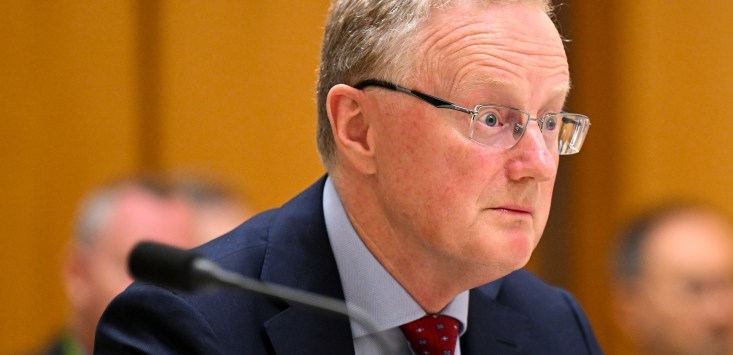
Source: AAP Image/Lukas Coch
Does the Reserve Bank (RBA) want house prices to rise? Why did they not hike interest rates on Tuesday?
The RBA has been relying on house prices falling to help reduce consumption and lower inflation. The famous “wealth effect” that makes homeowners spend more as their property rises in value has gone into reverse recently, with declining values making homeowners tighten their belts and spend less.
That’s a very deliberate strategy. The RBA has spelled out exactly how this works in the minutes of its monthly meetings.
“Declines in net wealth, driven by lower housing prices, would also weigh on spending,” it said in the minutes of the February meeting — at which they hiked interest rates by a quarter of a percentage point.
The RBA wants spending to fall, or at least to stop growing so quickly. The reason is that hot demand lets businesses raise prices. An electrician whose phone never stops ringing figures he can bump up prices by 10% and still be busy. A butcher who is selling out by 2pm concludes the same. Those business decisions — to raise prices — create inflation when they are repeated time and again across the economy. The RBA wants the electrician’s phone to stop ringing and the butcher to finish the trading day with lamb cutlets unsold. That way, the pressure is on them to cut prices, not raise them.
The RBA can affect spending in a number of ways. One is by compressing house prices. The people who reduce spending most when house prices fall are the wealthiest. It makes sense, right? The wealth effect can’t really hit people with no wealth — older demographics with their houses paid off tend to vary their spending most when property prices change.
If house prices rise, the wealthy spend more, the butcher and the electrician keep rising prices and the RBA’s fight against inflation gets harder. At the last moment, CoreLogic’s data shows house prices starting to stabilise and even rise. So why leave rates on hold?
As discussed here recently, the end of price falls need not mean the start of price rises. It’s important not to learn lessons from a subset of history, and while Australian property prices have risen in spectacular fashion over the past two decades, the full history of price changes says long periods of stasis are perfectly normal.
Nevertheless, the rise in Sydney prices can be a bellwether. Sydney’s price moves usually signal the future for other major markets. Does this sound surprising? Of course, in a stock market, if there’s a price pattern, people trade it until the pattern disappears: e.g. if you know prices are low every September, people buy in September until prices aren’t low in September anymore.
But housing markets aren’t liquid like stock markets, and it means the price patterns aren’t all eaten up by hedge funds doing algorithmic trading. Instead the patterns just sit there, visible to all, but very hard to make money from given stamp duty, etc.
The biggest patterns are that Sydney leads the rest of the country, and that the top end of the market leads the bottom end.
“The lift in housing values has been most evident across the upper quartile of Sydney’s housing market,” write CoreLogic in its recent house value index.
But the RBA paid this no heed. In fact, it trotted out the same old line that falling housing prices will compress spending. That may be true in some markets, but not the country’s biggest property market.
The bank has left itself the option to lift interest rates next time it meets, in early May. If auction clearance rates froth upwards and house prices show more signs of life, I’d tip at least one more rate rise.
This article was first published by Crikey.
Handpicked for you

Three ways to improve the $15 billion National Reconstruction Fund and revive manufacturing



COMMENTS
SmartCompany is committed to hosting lively discussions. Help us keep the conversation useful, interesting and welcoming. We aim to publish comments quickly in the interest of promoting robust conversation, but we’re a small team and we deploy filters to protect against legal risk. Occasionally your comment may be held up while it is being reviewed, but we’re working as fast as we can to keep the conversation rolling.
The SmartCompany comment section is members-only content. Please subscribe to leave a comment.
The SmartCompany comment section is members-only content. Please login to leave a comment.